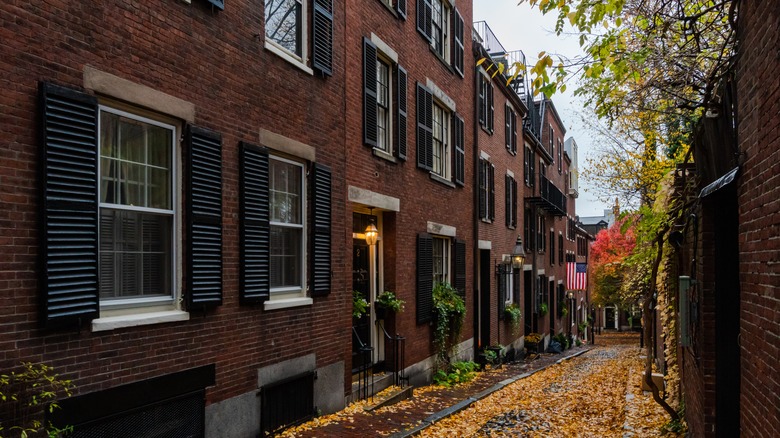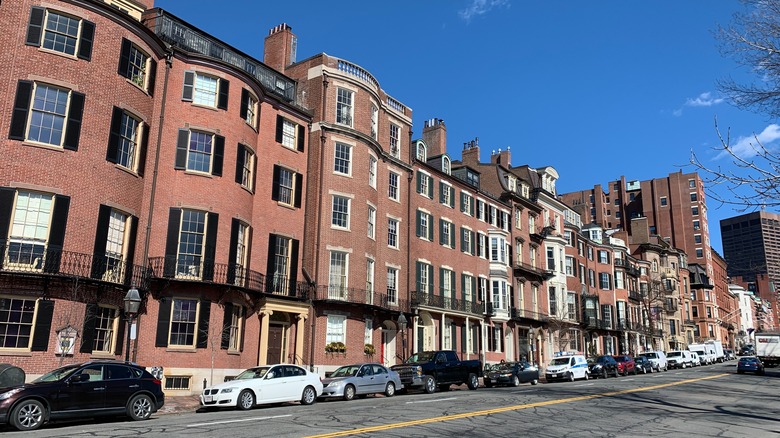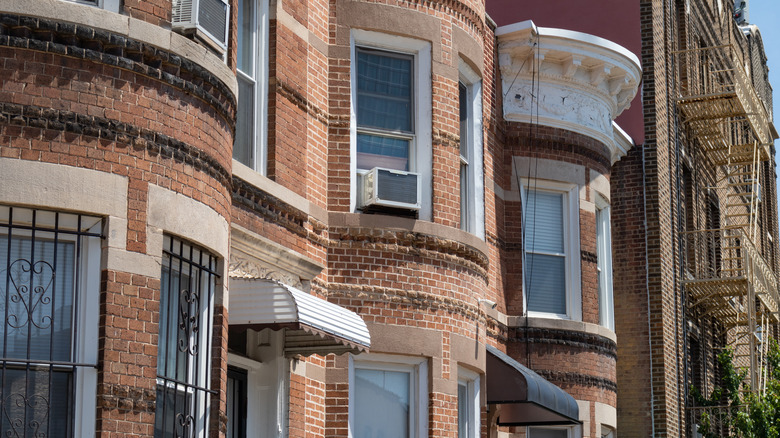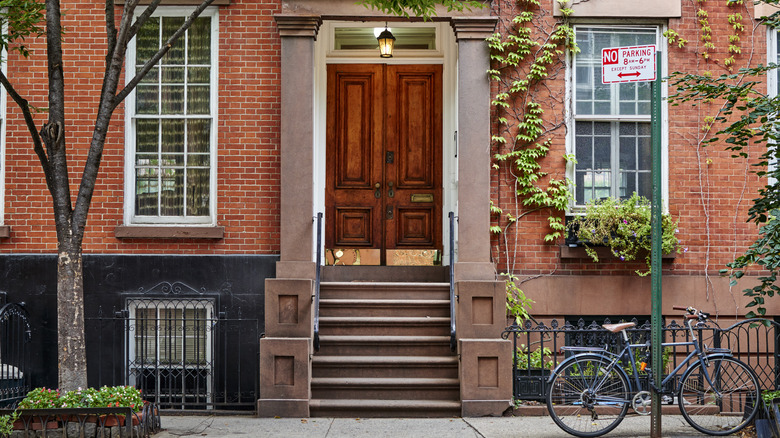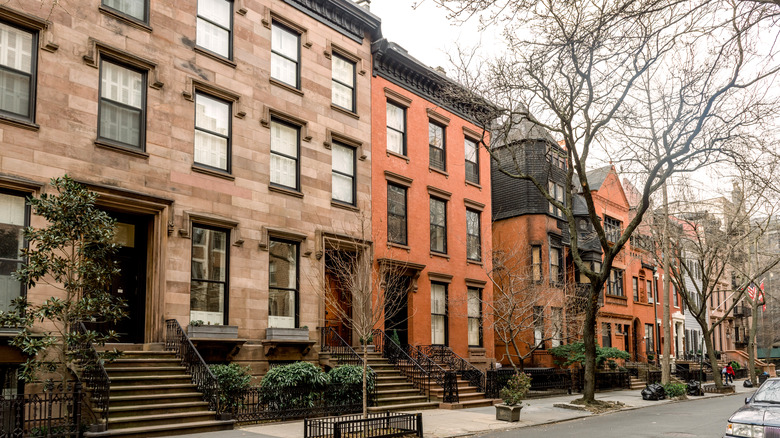Things To Think About Before Buying A Brownstone
When most people think of brownstone architecture, they think of the quintessential townhomes lining the streets of Brooklyn. What defines these homes as brownstones is their iconic brick and sandstone structure and Romantic Classicism-inspired features. These buildings are typically three to five stories tall with large front stoops and detailed moldings around the doors and windows. Many of them date back to the 19th century when brown sandstone was mined from northern state quarries. Now that these quarries are inactive and this material is no longer commonplace, these historical buildings are in limited supply and in high demand. Their landmark status gives them elevated value and they're exceptionally sought after due to their spacious interiors and towering ceilings.
Brownstones are different than other city apartments and townhomes. They fetch considerably higher purchase and rental prices, have historical value, and feature charming character. Many of these buildings also provide for urban living with an independent feel and your own exterior entrance. This differs greatly from typical city highrises with one main entrance. Here, you'll learn more about brownstones and what you should know before taking ownership of one of these properties.
You may be limited to living in certain states
Brownstone buildings are commonly associated with the rowhouses and townhouses throughout the Brooklyn and Manhattan boroughs of New York City, specifically in neighborhoods like Park Slope, Fort Greene, and Brooklyn Heights. However, brownstones are also found outside of The Empire State in other urban areas, including Baltimore, Boston, Chicago, and Philadelphia. They are typically restricted to these northern states because of their proximity to the sandstone quarries in the 19th and 20th centuries. There were four main quarries in Wisconsin, Pennsylvania, Connecticut, and New Jersey, which supplied the majority of this building material to nearby areas.
If you're searching for genuine brown sandstone rowhouses, you'll be limited to certain states that had access to these quarries when they were active, meaning you'll likely have to live in highly-developed areas. Remember that real estate and property laws can vary greatly between states, as well as property-related taxes. You may be set on a brownstone home, but you should also consider where that home is located and how local property laws and taxes will affect you going forward.
Buying this style may be competitive
Many people are drawn to brownstone due to the rich color and ornate detailing of its exterior. However, these valuable properties are not only desired for their gorgeous brickwork but they're also coveted because they're in limited supply. The quarries that once mined this material are no longer active within the United States, and most contractors and construction workers have transitioned to using other materials. New brownstone buildings are rarely built, and the ones that still standing are typically from the late 18th and early 19th centuries.
There has been a notable increase in interest in brownstones in past years, and there are several theories as to what sparked this rise in demand. The most recent influx of interest began in the 1980s when people began moving to cheaper, historic districts, which happened to be home to brownstones. Pop culture may also play a significant role, as brownstones appear regularly in television and movies. These homes also benefit families and individuals living in urban communities. They provide an outdoor area, sufficient square footage, and privacy in highly-condensed areas where such homes are difficult to find. According to a study in 2007, Mortgage Loan claims homes in historic districts had 5 to 35% property value increases every decade in comparison to non-historic neighborhoods, further boosting the interest in them.
It's likely to be located in an expensive neighborhood
Due to being erected in developing areas back in the 18th and 19th centuries, many brownstone rowhouses are located in well-known neighborhoods with convenient access to the city. They're often within walking distance of local pubs, restaurants, shops, and schools. Many of these neighborhoods are also located within historic districts, making these homes landmarks which increases their value and cost. Renovating these homes is often limited by city committees that oversee preserving old neighborhoods to ensure they don't lose their likeness to the past. These homes also tend to have strict homeowner's associations, which typically charge a monthly fee. Unlike other city high-rises and apartments, you'll pay inflated prices to live independently and do many things yourself. Luxury buildings often have full-service staff to receive mail, open doors, remove trash, and maintain the exterior. In contrast, when you live in a brownstone, these responsibilities fall to you.
Many brownstone owners aren't just responsible for the home itself — they're also responsible for the sidewalk in front of the house. Even though the public has access to this sidewalk, the homeowner is responsible for any damage and resulting repairs that must be done. When restoring your home and its property, you'll also need to find contractors permitted to restore historic buildings to their previous likeness. This can be more expensive than typical renovating since you'll have to source certain materials. Taxes are also important to consider— some historic districts have higher tax rates than typical neighborhoods. However, there are also grants, loans, and incentive programs to help homeowners afford these coveted properties.
The home may be outdated
Even if your brownstone was previously renovated, you have to remember that this building was likely built in the 1800s or 1900s. Given their age, these homes require routine structural, plumbing, and electrical work. You must also keep in mind that the defining sandstone that makes up these structures is porous and requires diligent inspections and upkeep. Unfortunately, this material is vulnerable to moisture, which seeps into its pores and expands when temperatures drop below freezing. This is of higher concern in northern states where winters are rough on sandstone and speed up the deterioration process.
In addition to an older exterior, brownstone buildings are often missing modern amenities. Centralized air conditioning and heating systems are rare since these luxuries are incredibly expensive to install around historical landmark limitations. Unless your brownstone was renovated after the 1960s to 1970s, when centralized AC became commonplace, you'll likely have to rely on mini-split, portable, or window air conditioning units.
The brownstone may be impractically designed
The features that define a brownstone may be aesthetically attractive but aren't always practical for everyday living. The stoops leading up to these rowhouses' front doors are visually pleasing, often adding to the classic ambiance of these historical buildings. However, they are very steep and may be difficult for older and differently-abled people to traverse. These stoops keep your home elevated above potential floodwater but make it harder to carry in groceries or shopping bags. Winters are especially perilous — you'll need to be proactive in removing ice buildup to reduce your risk of slipping and falling off the abrupt steps.
Brownstones are also known for having narrow staircases and no elevators. These staircases are too thin for larger pieces of furniture, and you must know your stairwell and entryway's dimensions before you start shopping for interior decor. Apartment-style brownstones often have winder stairs, which don't have landings and consistently coil to upper floors. Their cramped style and lack of a resting point make it very difficult to move oversized furniture to higher levels. The easiest solution to dealing with these details is to buy interior furnishings specialized for small spaces.
If you're on a budget, consider a multifamily home
With the high demand for brownstones, you're likely to find other aspiring buyers and renters. Keeping this in mind, you should consider purchasing a multifamily property to make owning this historic building more affordable. You'll be able to rent out units to other individuals or families, generating a passive income to help cover the costs of owning a brownstone. Seeing as these properties are highly desired for their appearance and proximity to cities, you'll likely be able to charge significant prices for rent.
You may need to make a few adjustments to ensure all units within a building are suitable to rent out to other people. Typically each unit should have a functional kitchen, bathroom, and living area. Plumbing and electricity must be up to code, and you'll need to keep up with renovations to appease your tenants and the previously mentioned historical landmark committees.
